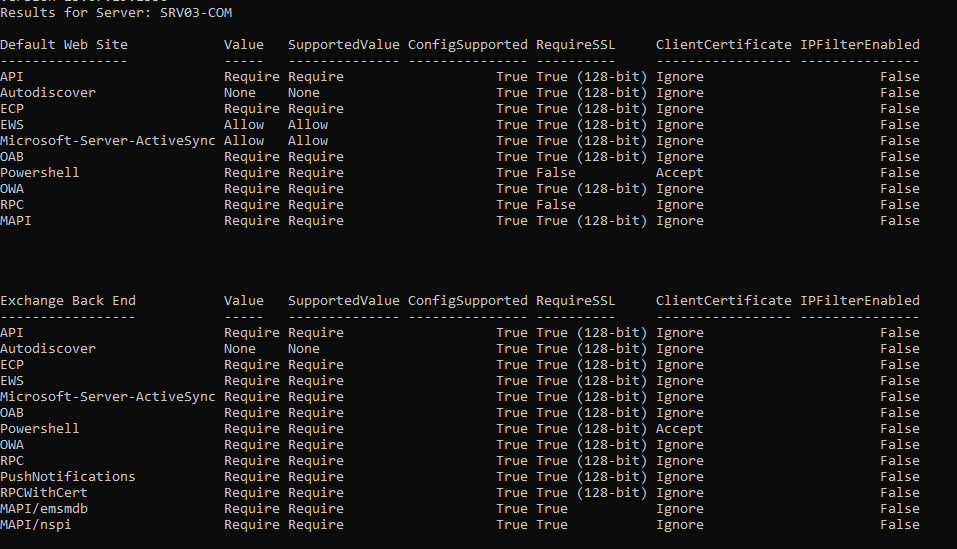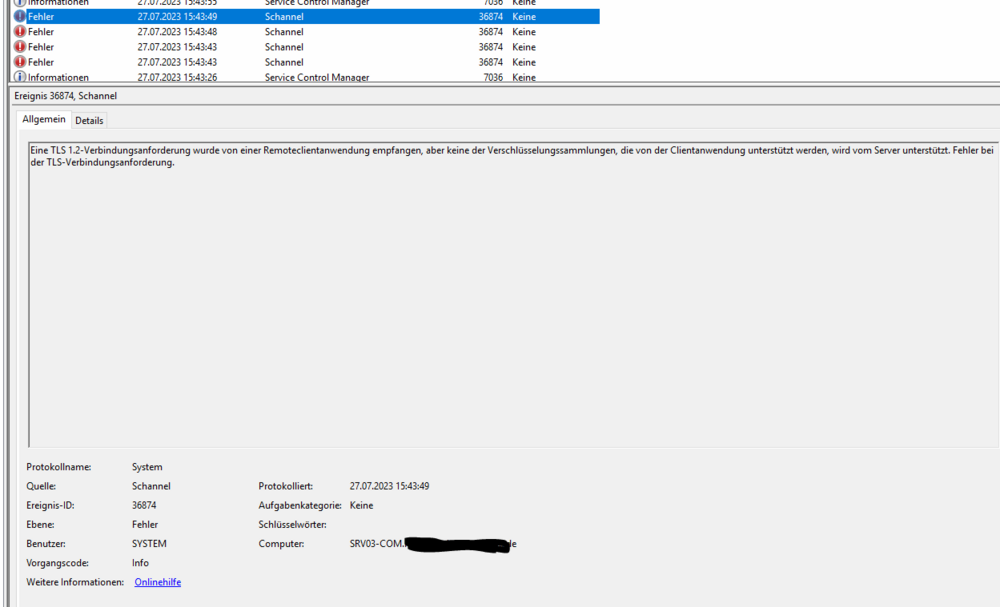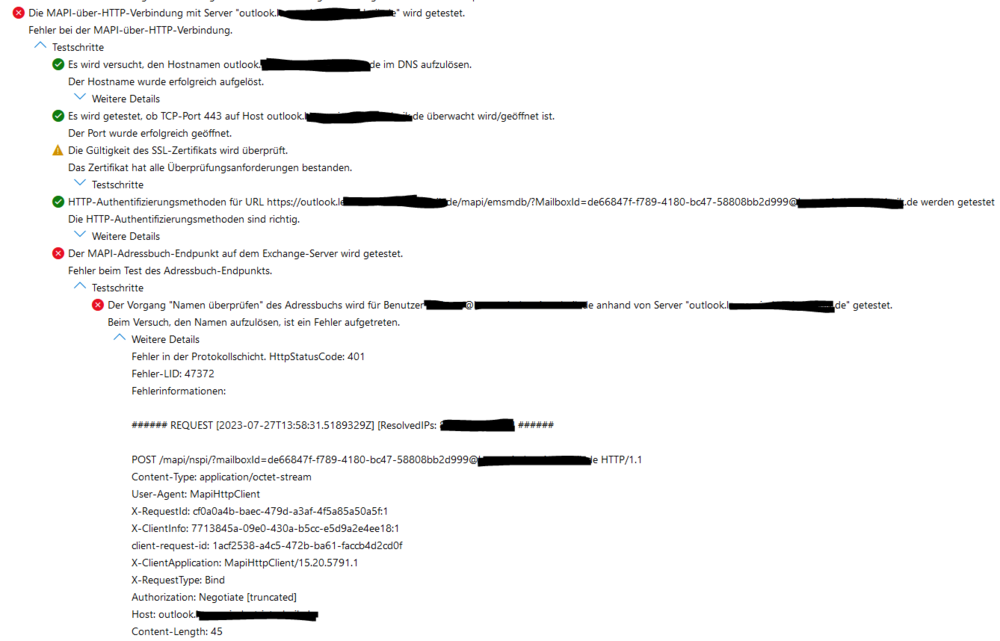
BennoIT
Members-
Gesamte Inhalte
7 -
Registriert seit
-
Letzter Besuch
Letzte Besucher des Profils
Der "Letzte Profil-Besucher"-Block ist deaktiviert und wird anderen Benutzern nicht angezeit.
Fortschritt von BennoIT
-
BennoIT folgt jetzt dem Inhalt: Exchange 2019 - Fehler bei der MAPI-über-HTTP-Verbindung. , Installation von Office 2019? und Outlook 365 Programmgesteuerter Zugriff
-
Installation von Office 2019?
BennoIT antwortete auf ein Thema von Scharping-FVB in: Windows Forum — Allgemein
Moin, so machen wir es zumindest immer. Geht sogar ziemlich schnell! Wir haben uns dafür z.B. immer zwei XML Dateien erstellt, dir wir von unserer Website passend herunterladen. Einmal mit, und einmal ohne Outlook. ohne z.B: <Language ID="de-de" /> <ExcludeApp ID="Access" /> <ExcludeApp ID="Lync" /> <ExcludeApp ID="OneDrive" /> <ExcludeApp ID="OneNote" /> <ExcludeApp ID="Outlook" /> <ExcludeApp ID="Publisher" /> <ExcludeApp ID="Teams" /> Lizenz bleibt normalerweise auch drin. Es muss im Anschluss also nix angepackt werden. -
Outlook 365 Programmgesteuerter Zugriff
BennoIT antwortete auf ein Thema von Rocknar in: Windows Forum — Allgemein
Grüß dich Rocknar, wir hatten einmal ähnliche Probleme. Habt Ihr das Problem nur am TS? Auf den Clients funktioniert also alles, ohne "Warnung"? Welche Anwendungen benötigen die Benutzer am TS aus dem Office 365 Business Plan wirklich? Nur Outlook, Excel etc. ? Werden dort auch OneDrive und/oder Teams aktiv genutzt? Wenn nicht, installieren wir teilweise Office 2021 LTSC, und da dann auch wirklich nur das, was gebraucht wird. Teils auch nur Outlook und Word. Hier haben wir oft weniger Probleme. Und auch die manuellen registry Einträge scheinen dann besser zu funktionieren. (Das ist natürlich nur eine Lösung, wenn eine nur sehr abgespeckte Office-Installation ausreichend ist) Grüße, Benno Und eine blöde Frage: Nen Neustart vom TS hast du aber schon durchgeführt, oder? -
Exchange 2019 - Fehler bei der MAPI-über-HTTP-Verbindung.
BennoIT antwortete auf ein Thema von BennoIT in: MS Exchange Forum
Exchange Health Checker version 23.07.20.2143 Virtual Machine detected. Certain settings about the host hardware cannot be detected from the virtual machine. Verify on the VM Host that: - There is no more than a 1:1 Physical Core to Virtual CPU ratio (no oversubscribing) - If Hyper-Threading is enabled do NOT count Hyper-Threaded cores as physical cores - Do not oversubscribe memory or use dynamic memory allocation Although Exchange technically supports up to a 2:1 physical core to vCPU ratio, a 1:1 ratio is strongly recommended for performance reasons. Certain third party Hyper-Visors such as VMWare have their own guidance. VMWare recommends a 1:1 ratio. Their guidance can be found at https://aka.ms/HC-VMwareBP2019. Related specifically to VMWare, if you notice you are experiencing packet loss on your VMXNET3 adapter, you may want to review the following article from VMWare: https://aka.ms/HC-VMwareLostPackets. For further details, please review the virtualization recommendations on Microsoft Docs here: https://aka.ms/HC-Virtualization. Exchange Information -------------------- Name: SRV03-COM.[KUNDE].de Generation Time: 08/01/2023 08:15:50 Version: Exchange 2019 CU13 Jun23SU Build Number: 15.02.1258.016 Exchange IU or Security Hotfix Detected: Security Update for Exchange Server 2019 Cumulative Update 13 (KB5026261) Server Role: Mailbox DAG Name: Standalone Server AD Site: Default-First-Site-Name MRS Proxy Enabled: False Internet Web Proxy: Not Set Extended Protection Enabled (Any VDir): True Setting Overrides Detected: True Name ModifiedBy Reason ComponentName SectionName Status Parameters ---- ---------- ------ ------------- ----------- ------ ---------- EnableSigningVe [KUNDE]- Enabling Data EnableSerializa Accepted Enabled=true rification [KUNDE]/Use Signing tionDataSigning rs/Administrato Verification r Exchange Server Maintenance: Server is not in Maintenance Mode Organization Information ------------------------ MAPI/HTTP Enabled: True Enable Download Domains: False AD Split Permissions: False Total AD Site Count: 1 Operating System Information ---------------------------- Version: Microsoft Windows Server 2019 Datacenter System Up Time: 4 day(s) 20 hour(s) 11 minute(s) 48 second(s) Time Zone: Mitteleuropäische Zeit Dynamic Daylight Time Enabled: True .NET Framework: 4.8 PageFile: C:\pagefile.sys Size: 4096MB Warning: On Exchange 2019, the recommended PageFile size is 25% (8192MB) of the total system memory (32768MB). More information: https://aka.ms/HC-PageFile Power Plan: Höchstleistung Http Proxy Setting: None Visual C++ 2012: Redistributable is outdated Visual C++ 2013: Redistributable is outdated Note: For more information about the latest C++ Redistributable please visit: https://aka.ms/HC-LatestVC This is not a requirement to upgrade, only a notification to bring to your attention. Server Pending Reboot: True --- Warning a reboot is pending and can cause issues on the server. HKLM:\SYSTEM\CurrentControlSet\Control\Session Manager\PendingFileRenameOperations More Information: https://aka.ms/HC-RebootPending Processor/Hardware Information ------------------------------ Type: HyperV Processor: Intel(R) Xeon(R) E-2278G CPU @ 3.40GHz Number of Processors: 1 Number of Physical Cores: 4 Number of Logical Cores: 8 Hyper-Threading: Enabled --- Not Applicable All Processor Cores Visible: Passed Max Processor Speed: 3408 Physical Memory: 32 GB Warning: We recommend for the best performance to have a minimum of 128GB of RAM installed on the machine. NIC Settings Per Active Adapter ------------------------------- Interface Description: Microsoft Hyper-V Network Adapter #3 [Ethernet 3] Driver Date: 2006-06-21 Driver Version: 10.0.17763.4492 MTU Size: 1500 Max Processors: 4 Max Processor Number: 6 Number of Receive Queues: 4 RSS Enabled: True Link Speed: 1000 Mbps --- This may not be accurate due to virtualized hardware IPv6 Enabled: False --- Warning IPv4 Address: Address: 192.168.100.3\24 Gateway: 192.168.100.200 IPv6 Address: DNS Server: 192.168.100.1 Registered In DNS: True Packets Received Discarded: 0 Disable IPv6 Correctly: False Error: IPv6 is disabled on some NIC level settings but not fully disabled. DisabledComponents registry value currently set to '0'. For details please refer to the following articles: https://aka.ms/HC-DisableIPv6 https://aka.ms/HC-ConfigureIPv6 Frequent Configuration Issues ----------------------------- TCP/IP Settings: 1800000 RPC Min Connection Timeout: 0 More Information: https://aka.ms/HC-RPCSetting FIPS Algorithm Policy Enabled: 0 CTS Processor Affinity Percentage: 0 Disable Async Notification: 0 Credential Guard Enabled: False EdgeTransport.exe.config Present: True Open Relay Wild Card Domain: Not Set DisablePreservation: Security Settings ----------------- TLS 1.0: Disabled RegistryKey Location Value ----------- -------- ----- Enabled SYSTEM\CurrentControlSet\Control\SecurityProviders\SCHANNEL\Protocols\TLS 0 1.0\Server DisabledByDefault SYSTEM\CurrentControlSet\Control\SecurityProviders\SCHANNEL\Protocols\TLS 1 1.0\Server Enabled SYSTEM\CurrentControlSet\Control\SecurityProviders\SCHANNEL\Protocols\TLS 0 1.0\Client DisabledByDefault SYSTEM\CurrentControlSet\Control\SecurityProviders\SCHANNEL\Protocols\TLS 1 1.0\Client TLS 1.1: Disabled RegistryKey Location Value ----------- -------- ----- Enabled SYSTEM\CurrentControlSet\Control\SecurityProviders\SCHANNEL\Protocols\TLS 0 1.1\Server DisabledByDefault SYSTEM\CurrentControlSet\Control\SecurityProviders\SCHANNEL\Protocols\TLS 1 1.1\Server Enabled SYSTEM\CurrentControlSet\Control\SecurityProviders\SCHANNEL\Protocols\TLS 0 1.1\Client DisabledByDefault SYSTEM\CurrentControlSet\Control\SecurityProviders\SCHANNEL\Protocols\TLS 1 1.1\Client TLS 1.2: Enabled RegistryKey Location Value ----------- -------- ----- Enabled SYSTEM\CurrentControlSet\Control\SecurityProviders\SCHANNEL\Protocols\TLS 1 1.2\Server DisabledByDefault SYSTEM\CurrentControlSet\Control\SecurityProviders\SCHANNEL\Protocols\TLS 0 1.2\Server Enabled SYSTEM\CurrentControlSet\Control\SecurityProviders\SCHANNEL\Protocols\TLS 1 1.2\Client DisabledByDefault SYSTEM\CurrentControlSet\Control\SecurityProviders\SCHANNEL\Protocols\TLS 0 1.2\Client TLS 1.3: Disabled RegistryKey Location Value ----------- -------- ----- Enabled SYSTEM\CurrentControlSet\Control\SecurityProviders\SCHANNEL\Protocols\TLS 0 1.3\Server DisabledByDefault SYSTEM\CurrentControlSet\Control\SecurityProviders\SCHANNEL\Protocols\TLS 1 1.3\Server Enabled SYSTEM\CurrentControlSet\Control\SecurityProviders\SCHANNEL\Protocols\TLS 0 1.3\Client DisabledByDefault SYSTEM\CurrentControlSet\Control\SecurityProviders\SCHANNEL\Protocols\TLS 1 1.3\Client RegistryKey Location Value ----------- -------- ----- SystemDefaultTlsVersions SOFTWARE\Microsoft\.NETFramework\v4.0.30319 1 SchUseStrongCrypto SOFTWARE\Microsoft\.NETFramework\v4.0.30319 1 SystemDefaultTlsVersions SOFTWARE\Wow6432Node\Microsoft\.NETFramework\v4.0.30319 1 SchUseStrongCrypto SOFTWARE\Wow6432Node\Microsoft\.NETFramework\v4.0.30319 1 SystemDefaultTlsVersions SOFTWARE\Microsoft\.NETFramework\v2.0.50727 1 SchUseStrongCrypto SOFTWARE\Microsoft\.NETFramework\v2.0.50727 1 SystemDefaultTlsVersions SOFTWARE\Wow6432Node\Microsoft\.NETFramework\v2.0.50727 1 SchUseStrongCrypto SOFTWARE\Wow6432Node\Microsoft\.NETFramework\v2.0.50727 1 SecurityProtocol: Tls, Tls11, Tls12 TlsCipherSuiteName CipherSuite Cipher Certificate Protocols ------------------ ----------- ------ ----------- --------- TLS_ECDHE_ECDSA_WITH_AES_256_GCM_SHA384 49196 AES ECDSA TLS_1_2 & DTLS_1_1 TLS_ECDHE_ECDSA_WITH_AES_128_GCM_SHA256 49195 AES ECDSA TLS_1_2 & DTLS_1_1 TLS_ECDHE_RSA_WITH_AES_256_GCM_SHA384 49200 AES RSA TLS_1_2 & DTLS_1_1 TLS_ECDHE_RSA_WITH_AES_128_GCM_SHA256 49199 AES RSA TLS_1_2 & DTLS_1_1 TLS_ECDHE_ECDSA_WITH_AES_256_CBC_SHA384 49188 AES ECDSA TLS_1_2 & DTLS_1_1 TLS_ECDHE_ECDSA_WITH_AES_128_CBC_SHA256 49187 AES ECDSA TLS_1_2 & DTLS_1_1 TLS_ECDHE_RSA_WITH_AES_256_CBC_SHA384 49192 AES RSA TLS_1_2 & DTLS_1_1 TLS_ECDHE_RSA_WITH_AES_128_CBC_SHA256 49191 AES RSA TLS_1_2 & DTLS_1_1 AllowInsecureRenegoClients Value: 0 AllowInsecureRenegoServers Value: 0 LmCompatibilityLevel Settings: 3 Description: Clients use only NTLMv2 authentication, and they use NTLMv2 session security if the server supports it. Domain controllers accept LM, NTLM, and NTLMv2 authentication. SMB1 Installed: False SMB1 Blocked: True Certificate: FriendlyName: [KUNDE] Exchange Zertifikat Thumbprint: 466DC43A3ED2925537C5E5EDB3F84F6C3EFBB11C Lifetime in days: 360 Certificate has expired: False Certificate status: Valid Key size: 2048 Signature Algorithm: sha256RSA Signature Hash Algorithm: sha256 Bound to services: IMAP, POP, IIS, SMTP Internal Transport Certificate: True Current Auth Certificate: False Next Auth Certificate: False SAN Certificate: True Namespaces: outlook.[KUNDE].de autodiscover.[KUNDE].de Certificate: FriendlyName: Exchange Zertifikat Thumbprint: 9F706F403400554ED54CEE52A3EB73E11F805274 Lifetime in days: 318 Certificate has expired: False Certificate status: PendingRequest Key size: 2048 Signature Algorithm: sha1RSA Signature Hash Algorithm: sha1 It's recommended to use a hash algorithm from the SHA-2 family More information: https://aka.ms/HC-SSLBP Bound to services: None Internal Transport Certificate: False Current Auth Certificate: False Next Auth Certificate: False SAN Certificate: True Namespaces: outlook.[KUNDE].de autodiscover.[KUNDE].de [KUNDE].de Certificate: FriendlyName: Microsoft Exchange Thumbprint: 7EF95706A7D2F8C8D125DB07A702C7127AFA0925 Lifetime in days: 1461 Certificate has expired: False Certificate status: Valid Key size: 2048 Signature Algorithm: sha256RSA Signature Hash Algorithm: sha256 Bound to services: SMTP Internal Transport Certificate: False Current Auth Certificate: False Next Auth Certificate: False SAN Certificate: True Namespaces: SRV03-COM SRV03-COM.[KUNDE].de Certificate: FriendlyName: Exchange Delegation Federation Thumbprint: 3D9E55162C657995FA9C6A4087C6D6691272979A Lifetime in days: 1140 Certificate has expired: False Certificate status: Valid Key size: 2048 Signature Algorithm: sha256RSA Signature Hash Algorithm: sha256 Bound to services: SMTP, Federation Internal Transport Certificate: False Current Auth Certificate: False Next Auth Certificate: False SAN Certificate: False Namespaces: Federation Certificate: FriendlyName: Exchange Delegation Federation Thumbprint: EEA137B69935E4697EEABDA73FB75BB8AD0C506F Lifetime in days: 1013 Certificate has expired: False Certificate status: Valid Key size: 2048 Signature Algorithm: sha256RSA Signature Hash Algorithm: sha256 Bound to services: SMTP Internal Transport Certificate: False Current Auth Certificate: False Next Auth Certificate: False SAN Certificate: False Namespaces: Federation Certificate: FriendlyName: Microsoft Exchange Server Auth Certificate Thumbprint: F188BA74068F2A7ACD1983AA9C50157C83E06668 Lifetime in days: 987 Certificate has expired: False Certificate status: Valid Key size: 2048 Signature Algorithm: sha1RSA Signature Hash Algorithm: sha1 It's recommended to use a hash algorithm from the SHA-2 family More information: https://aka.ms/HC-SSLBP Bound to services: None Internal Transport Certificate: False Current Auth Certificate: True Next Auth Certificate: False SAN Certificate: False Namespaces: Microsoft Exchange Server Auth Certificate Certificate: FriendlyName: Microsoft Exchange Thumbprint: AE3B317B0C937FCE7B4C03C32CC0239369A44252 Lifetime in days: 1013 Certificate has expired: False Certificate status: Valid Key size: 2048 Signature Algorithm: sha1RSA Signature Hash Algorithm: sha1 It's recommended to use a hash algorithm from the SHA-2 family More information: https://aka.ms/HC-SSLBP Bound to services: IIS Internal Transport Certificate: False Current Auth Certificate: False Next Auth Certificate: False SAN Certificate: True Namespaces: SRV03-COM SRV03-COM.[KUNDE].de Certificate: FriendlyName: WMSVC-SHA2 Thumbprint: B424FD5B10F70218A5289070F1FBD8EA66488D80 Lifetime in days: 2837 Certificate has expired: False Certificate status: Valid Key size: 2048 Signature Algorithm: sha256RSA Signature Hash Algorithm: sha256 Bound to services: SMTP Internal Transport Certificate: False Current Auth Certificate: False Next Auth Certificate: False SAN Certificate: False Namespaces: WMSvc-SHA2-SRV03-COM Valid Internal Transport Certificate Found On Server: True Valid Auth Certificate Found On Server: True AMSI Enabled: True SerializedDataSigning Enabled: True Strict Mode disabled: False BaseTypeCheckForDeserialization disabled: False Exchange Emergency Mitigation Service: Enabled Windows service: Running Pattern service: 200 - Reachable Mitigation applied: PING1 Run: 'Get-Mitigations.ps1' from: 'D:\Programme\Exchange Server\scripts\' to learn more. Telemetry enabled: True FIP-FS Update Issue Detected: True Detected problematic FIP-FS version 2201010009 directory Although it should not cause any problems, we recommend performing a FIP-FS reset More Information: https://aka.ms/HC-FIPFSUpdateIssue Security Vulnerability ---------------------- IIS module anomalies detected: False Security Vulnerability: Download Domains are not configured. You should configure them to be protected against CVE-2021-1730. Configuration instructions: https://aka.ms/HC-DownloadDomains Exchange IIS Information ------------------------ Name State Protocol - Bindings - Certificate ---- ----- --------------------------------- Default Web Site Started http - *:80: - https - :443: - 466DC43A3ED2925537C5E5EDB3F84F6C3EFBB11C http - 127.0.0.1:80: - https - 127.0.0.1:443: - 466DC43A3ED2925537C5E5EDB3F84F6C3EFBB11C Exchange Back End Started http - *:81: - https - *:444: - AE3B317B0C937FCE7B4C03C32CC0239369A44252 AppPoolName State GCServerEnabled RestartConditionSet ----------- ----- --------------- ------------------- MSExchangeMapiFrontEndAppPool Started False False MSExchangeOWAAppPool Started False False MSExchangeECPAppPool Started False False MSExchangeRestAppPool Started False False MSExchangeMapiAddressBookAppPool Started False False MSExchangeRpcProxyFrontEndAppPool Started False False MSExchangePowerShellAppPool Started False False MSExchangePowerShellFrontEndAppPool Started False False MSExchangeRestFrontEndAppPool Started False False MSExchangeMapiMailboxAppPool Started False False MSExchangeOABAppPool Started False False MSExchangePushNotificationsAppPool Started False False MSExchangeOWACalendarAppPool Started False False MSExchangeAutodiscoverAppPool Started False False MSExchangeServicesAppPool Started False False MSExchangeSyncAppPool Started True False MSExchangeRpcProxyAppPool Started False False Output file written to .\HealthChecker-SRV03-COM-20230801081355.txt Exported Data Object Written to .\HealthChecker-SRV03-COM-20230801081355.xml -
Exchange 2019 - Fehler bei der MAPI-über-HTTP-Verbindung.
BennoIT antwortete auf ein Thema von BennoIT in: MS Exchange Forum
Alles klar, ich werde dem auch nochmal nachgehen. Kann bisher hierzu auf der Firewall aber nichts finden. Wir nutzen eine Lancom R&S UF-200. Sollte mich das hier eigentlich irritieren? Der Screenshot ist von unserem Exchange. RPC steht bei "RequireSSL" noch auf "False" Bei MAPI/emsmdb und MAPI/nspi fehlt der Eintrag (128-bit) Laut den Screenshots von Frank Zöchling wäre das zumindest nicht korrekt. LG Benno -
Exchange 2019 - Fehler bei der MAPI-über-HTTP-Verbindung.
BennoIT antwortete auf ein Thema von BennoIT in: MS Exchange Forum
Touché! Die Aussage hätte ich vielleicht besser verpacken sollen :D Beim Kunden Vor-Ort ist ebenfalls eine Kaspersky Endpoint Security installiert. Also auch auf den Clients. Ich habe das ganze aber auch schon auf einem relativ frischen Windows 11/ 10 ausprobiert. Da war auch mit ausgeschalteter Windows Security nix zu machen. Ich halte diesen Anhalspunkt ohnehin für wenig erfolgsversprechend. Immerhin komme ich ja bereits bei dem Verbindungstest durch Microsoft nicht weiter. Dies schließt für mich eine alleinige Ursache auf Seite des Clients aus. Korrigiere mich bitte, wenn ich da falsch liege :) Könntest du vielleicht deinen Gedanken zum deinem ersten Tipp nochmal weiterführen? Dies würde zumindest zum zeitlichen Ablauf des Problems passen. Haben zuvor nie Probleme mit dem Exchange gehabt und mich daran doch ein weile aufgehalten. Hier würde ich mich durchaus selbst als Fehlerquelle nicht auschließen wollen. :-) -
Exchange 2019 - Fehler bei der MAPI-über-HTTP-Verbindung.
BennoIT antwortete auf ein Thema von BennoIT in: MS Exchange Forum
Habe ich bereits durchgeführt! Darf/ soll ich den ganzen Auszug davon posten? Oder schwebt die etwas bestimmtes vor? Hi Norbert, danke dir schonmal für die schnelle Rückmeldung! Extended Protection habe ich tatsächlich erst vor zwei Wochen aktiviert, weil mich die Meldung im HealthChecker genervt hat, und das Thema ja sowieso erledigt werden musste. Hier müsstest du mir einmal auf die Sprünge helfen, was du genau mit "überall dasselbe Zertifikat" meinst. Hier ist seit gestern ein neues SSL Multi-Domain Zertifikat im Einsatz. Für mich scheint damit auch alles funktioniert zu haben. Bzgl. Antivirus habe ich mal alles deaktiviert. Hier ist ein Kaspersky Security 9.0 für Microsoft Exchange Server im Einsatz. Bisher hat dies aber zu keinem Erfolg geführt. LG Benno Tatsächlich bin ich mir hier unsicher und gerade mal am nachforschen... Das Problem... die Domain des Kunden ist vor gut einem Monat von einem anderen Anbieter (1&1) zu unserem (DomainFactory) gewandert. Nun bekommt der Kunde eine neue Website über einen weiteren Dienstleister. Dieser hat zu einem externen WebServer geraten, um die Website zu hosten. Die Website wird also nach da umgeleitet. Der Kunde selbst besitzt eine feste IP-Adresse. Passende A-Records wurden beim Hoster damals eingetragen, damit alles was den Exchange betrifft, direkt dort landet. LG Benno -
Exchange 2019 - Fehler bei der MAPI-über-HTTP-Verbindung.
BennoIT hat einem Thema erstellt in: MS Exchange Forum
Hallo zusammen, ich benötige einmal eure Unterstützung bei einem meiner Kunden. Hier wurde mir heute berichtet, dass man sich wohl nicht mehr außerhalb des Firmennetzwerks per Outlook mit dem Exchange Server verbinden kann. Zudem würde ständig nach dem Kennwort gefragt. Es gibt aber wohl auch noch Outlook Installationen, die "noch" ohne Probleme laufen. Auch untwegs, außerhalb des Firmennetzwerks. Der Server wurde erst vor kurzem auf folgende Version gebracht: Version: Exchange 2019 CU13 Jun23SU Build Number: 15.02.1258.016 Es kann nicht ausgeschlossen werden, dass die Probleme schon seit dem bestehen. (ca. 2Wochen) SSL Zertifikat läuft am Montag aus und wurde daher heute in der Verzweiflung auch bereits erneuert und aktiviert. OWA, ActiveSync laufen ohne Probleme. Ich bin um jede Hilfe dankbar - bitte seht mir nach, dass MS Exchange nicht mein Steckenpferd ist! :-) Ich habe als erstes über https://testconnectivity.microsoft.com/tests/exchange die Anbindung getestet. Hier erhalte ich relativ früh folgende Fehlermeldung: Die MAPI-über-HTTP-Verbindung mit Server "outlook.[KUNDE].de" wird getestet. Fehler bei der MAPI-über-HTTP-Verbindung. Hier der Rest der Ausgabe: Der Vorgang "Namen überprüfen" des Adressbuchs wird für Benutzer [Benutzer]@[KUNDE].de anhand von Server "outlook.[KUNDE].de" getestet. Beim Versuch, den Namen aufzulösen, ist ein Fehler aufgetreten. Weitere Details Fehler in der Protokollschicht. HttpStatusCode: 401 Fehler-LID: 47372 Fehlerinformationen: ###### REQUEST [2023-07-27T13:58:31.5189329Z] [ResolvedIPs: x.x.x.x] ###### POST /mapi/nspi/?mailboxId=de66847f-f789-4180-bc47-58808bb2d999@[KUNDE].de HTTP/1.1 Content-Type: application/octet-stream User-Agent: MapiHttpClient X-RequestId: cf0a0a4b-baec-479d-a3af-4f5a85a50a5f:1 X-ClientInfo: 7713845a-09e0-430a-b5cc-e5d9a2e4ee18:1 client-request-id: 1acf2538-a4c5-472b-ba61-faccb4d2cd0f X-ClientApplication: MapiHttpClient/15.20.5791.1 X-RequestType: Bind Authorization: Negotiate [truncated] Host: outlook.[KUNDE].de Content-Length: 45 --- REQUEST BODY [+0.304] --- ..[BODY SIZE: 45] --- REQUEST SENT [+0.304] --- ###### RESPONSE [+0.606] ###### HTTP/1.1 401 Unauthorized request-id: 70f37175-63b2-4449-9a8c-17af60973f61 X-OWA-Version: 15.2.1258.16 X-FailureContext: FrontEnd;401;VW5hdXRob3JpemVk;;;; Server: Microsoft-IIS/10.0 WWW-Authenticate: Negotiate,NTLM X-Powered-By: ASP.NET X-FEServer: SRV03-COM Date: Thu, 27 Jul 2023 13:58:31 GMT Content-Length: 0 --- RESPONSE BODY [+0.606] --- --- RESPONSE DONE [+0.606] --- ###### EXCEPTION THROWN [+0.606] ###### HTTP-Antwortkopfzeilen: request-id: 70f37175-63b2-4449-9a8c-17af60973f61 X-OWA-Version: 15.2.1258.16 X-FailureContext: FrontEnd;401;VW5hdXRob3JpemVk;;;; Server: Microsoft-IIS/10.0 WWW-Authenticate: Negotiate,NTLM X-Powered-By: ASP.NET X-FEServer: SRV03-COM Date: Thu, 27 Jul 2023 13:58:31 GMT Content-Length: 0 HTTP-Statuscode: 401 Unauthorized Parallel zu dem Test erhalte ich auf dem Exchange Server folgenden Fehler in der Ereignianzeige: - <Event xmlns="http://schemas.microsoft.com/win/2004/08/events/event"> - <System> <Provider Name="Schannel" Guid="{1f678132-5938-4686-9fdc-c8ff68f15c85}" /> <EventID>36874</EventID> <Version>0</Version> <Level>2</Level> <Task>0</Task> <Opcode>0</Opcode> <Keywords>0x8000000000000000</Keywords> <TimeCreated SystemTime="2023-07-27T13:43:49.125780100Z" /> <EventRecordID>986032</EventRecordID> <Correlation ActivityID="{7dcce9f8-c071-0006-0dea-cc7d71c0d901}" /> <Execution ProcessID="908" ThreadID="32120" /> <Channel>System</Channel> <Computer>SRV03-COM.[KUNDE].de</Computer> <Security UserID="S-1-5-18" /> </System> - <EventData> <Data Name="Protocol">TLS 1.2</Data> </EventData> </Event>



